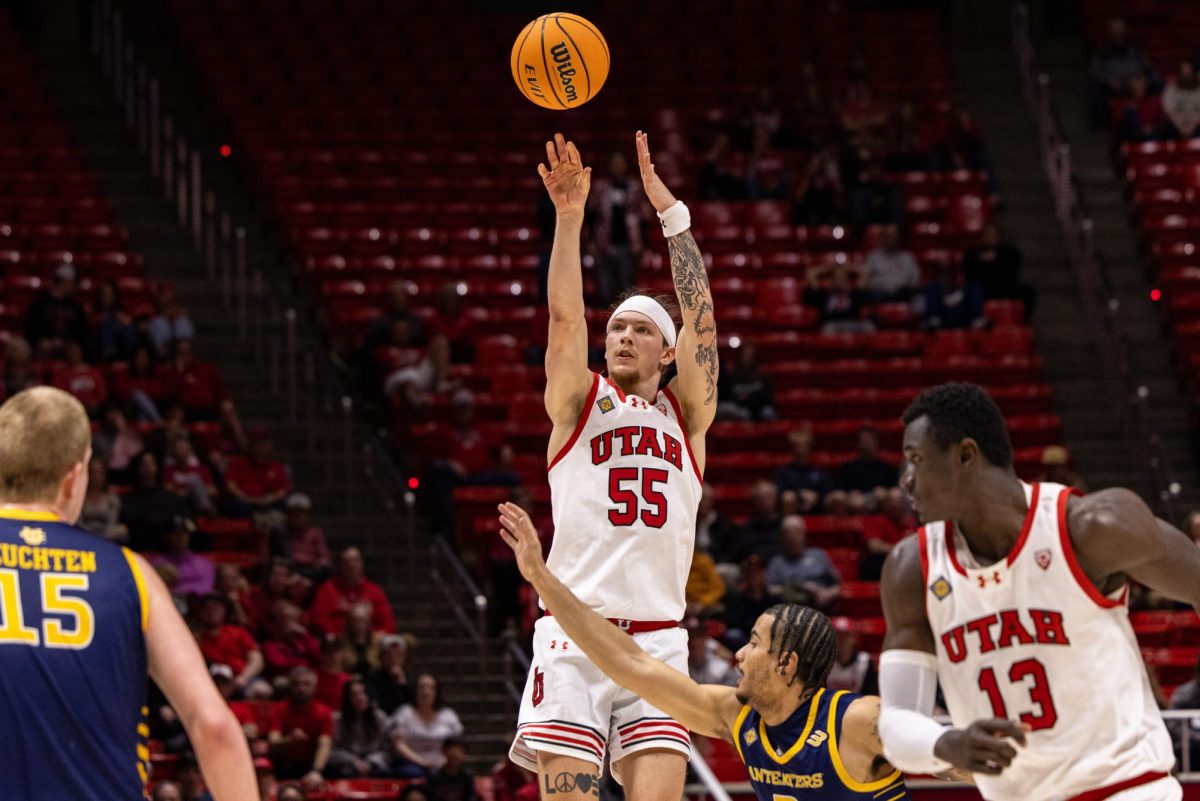Langley: Utah Legislature Tackles Wasteful Grass
(Graphic by Madelyn Foulger | The Daily Utah Chronicle)
February 7, 2023
With the recent reports on the precarious future of the Great Salt Lake, many Utahns have voiced their concern about Utah’s water conservation practices. Thankfully, members of our legislature, namely Rep. Doug Owens, Rep. Douglas Welton and Sen. Scott Sandall, have put forth bills that work to reverse our extensive water misuse. Specifically, H.B. 188, H.B. 272 and S.B. 118 create new regulations and expectations for lawns. They also establish incentive programs, giving citizens financial compensation when converting their lawns.
The west needs a new approach to resource management, and these bills take Utah in the right direction.
The two most similar bills out of this trio, H.B. 272 and S.B. 118, were sponsored by Owens and Sandall. Their main goal is to establish more regulations on how citizens and businesses use water in Utah, especially regarding irrigation and lawn care. Utah, the second driest state in the nation, has experienced droughts and poor water management for decades. While the redirection of many of Utah’s rivers is one of the primary causes of the Great Salt Lake’s disappearance, lush lawns also add to our problems.
Chronicle writer KC Ellen Cushman explains more about the need to phase out lawns in the west in the article, “Utah Needs to Wage War on Grass in Public Spaces.” Lawns or non-functional turfs make up nearly 50% of American outdoor water use. Around 50% of this water inevitably evaporates or runs off the intended surface, going to waste.
Rep. Owens, the sponsor for H.B. 272, explained how it would help reduce wasteful water use in Utah. He explained that the bill is made up of two parts. The first is an extension to the Utah Water District’s funds “to a total of about $22 million a year to help people pay for taking out their sod where they want to take up turf.” While this bill helps Utah citizens act against wasteful water, it also holds companies and cities accountable for their new turf. He explains that in the second portion, “it requires cities to require that non-functional turf be disallowed on new construction.” In addition to S.B. 118, which refines the system for turf-removal incentives, these bills will help improve Utah’s water situation.
Xeriscaping as a style of landscaping has become popular in the west for its use of little to no water. With lawn replacement programs like the ones presented in these bills, we could see many more xeriscaped plots implemented in Utah. While some think that xeriscaping involves only rocky, dead-looking plots, they can be green and aesthetically pleasing. Instead of planting traditional grass, one could plant native vegetation that consumes much less water per annum. In his interview with the Chronicle, Owens addressed this concern: “We still want to avoid becoming heat islands. We still want trees, we still want shrubs and we still want people to be able to have grass if they’re actually using it.”
H.B. 188, a smaller bill introduced by Welton, tied up this initiative nicely by introducing new requirements for some of the most enormous turfs in our country: Golf courses. This bill would have required Utah golf to report the amount of water they use every year publicly to keep them accountable. In Salt Lake County alone, golf courses use up to 9 million gallons of water daily to keep their turf in peak condition. This massive water expenditure only services around 8% of the population that happen to play golf — most of whom are members of the upper class, creating a clear hierarchy of priority within Utah policy. However, despite the clear need for these regulations, the bill faced much adversity during its first hearing. After many comments, almost entirely made by those a part of or representing the golf industry, the bill is likely to exclude private golf courses if passed.
Peace From the War Against Water in Utah
While these bills only scratch the surface of the need for an extensive rework of our water management in Utah, they take steps in the right direction. Following in the footsteps of Las Vegas and California, which have passed similar grass and irrigation regulations, our state can reduce our abysmally high water use.
There is still room for improvement and further action, however. H.B. 188, in particular, failed to impose more stringent regulations on golf courses despite calls from some of Utah’s most drought-prone areas. While it may have been struck down by private golf and their constituents, our representatives and citizens cannot stop their fight against golf and their wasteful water habits.
How Utahns See These Bills
Concerned citizens from the environmentalist organization Save Our Great Salt Lake spoke to us about their concerns with these bills. Chandler Rosenberg, an organizer with the group, expressed her discontent by saying “[Reducing lawns is] definitely an important thing that needs to be done, but that will not save the Great Salt Lake.” Chandler explained that Utah needs an “all of the above approach” when dealing with our water crisis. When asked about their opinion on the stringency and failure of H.B. 188, they said “we need to go farther, but our legislature won’t even go that far.”
The Great Salt Lake and the many other beautiful waters of Utah are pillars of this ecosystem and earthly sources of unity amongst Utahns. Reducing our water usage is a responsibility granted to those living today by the ignorant and careless acts of those who came before us. The systems put in place by these bills facilitate this healing process tremendously. If these bills pass, they will help many Utahns do their part for their community and their earth.









